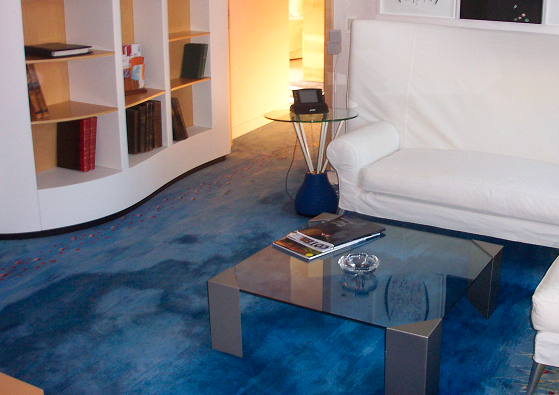Carpet Patches
Complaint:
Patches of a cut pile carpet have changed colour in a random manner, cause unknown. This happened about six months after carpet was first installed. Areas affected: whole of downstairs floor area.
Date installed: 1 March 2005
Retailer: XX
Action so far: Retailer has been to look at carpet, but claims fault is caused by damp floor, and he can therefore not accept responsibility.
Carpet mill: XX

The nature of the complaint is colour loss in random patches over the carpet.
Upon seeing the carpet it is clearly obvious that the carpet has suffered a severe shade change. If we were to compare an unused off-cut, I believe this would show that the light blue shade that predominates the design has become considerably darker in shade.
I understand that the problem was first noticed approximately six months after installation.
There are a number of reasons why shade changes in a carpet. These options are describe in some detail below.
- Shade may change as a result of light fading
I don’t believe this is the cause as there appears to be little natural daylight in the room and area where the patches have appeared. Light fading would also normally make the patches lighter rather than darker.
- Shade change may occur as a consequence of soiling.
Normally, such changes are either the result of dirt being carries in from outside, or occasionally following internal construction work. Changes caused by soiling from either of these causes usually results in ‘tracking’ where the area that is closest to the door, or closest the work carried out, is the worst affected area.
Assuming no internal or major external works have been carried out, and with ‘normal’ use over the last six months, nether seem to be the cause in this instance.
- Shade changes may occur if the carpet has been excessively wet during cleaning, or has been cleaned with an alkaline detergent.
I assume the carpet has not been wet cleaned since new being only six months old.
- It could also be gas fading as a result of the release of ammonia from the sub-floor screeding; colour changes following contamination by road salt; and bleaching of the base wool shade following exposure to ultra-violet light.
5. Pile reversal, also known as shading or watermarking. It is a very common occurrence in cut pile carpets.
This can be confirmed by examining the patches from every angle. If the ‘darker’ patches become ‘lighter’ and the ‘lighter’ patches become ‘darker’ then this confirms pile reversal.
Another test is to look at the direction of the pile on the very edges of the patches. You should notice the pile facing one direction in the patch and the pile facing another direction outside the patch.
The problem is always worse in plain or near plain carpets. Patterns tend to confuse the eye and disguise the effects of pile reversal. It also tends to be worse in dense pile carpets.
Pile reversal can appear in any carpet irrespective of the manufacturing process.